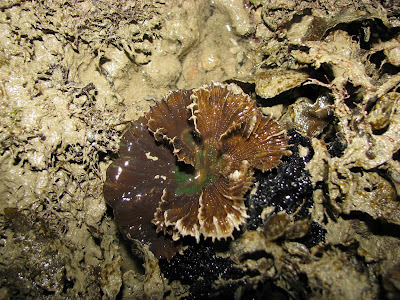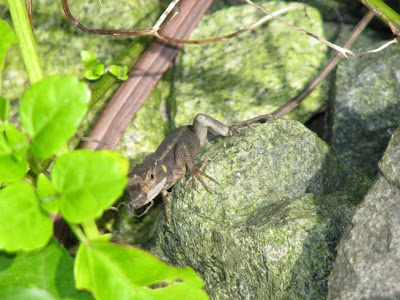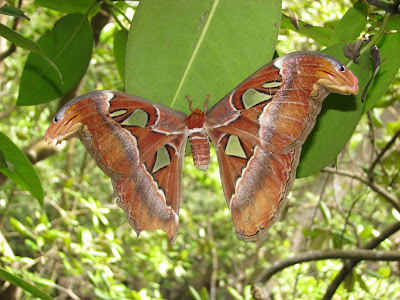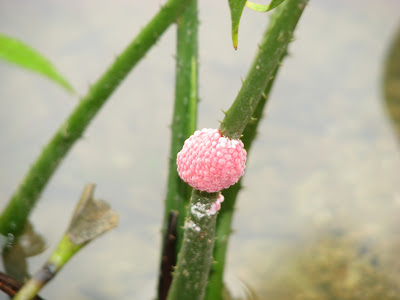Christmas day at Pulau Semakau. A bunch of us were out at the intertidals at a field trip; a coral workshop conducted by Jani. Lets see what kind of corals can be found exposed in the intertidals.

A typical Singaporean will asked: "Singapore got corals meh?" At first glance, it does seemed that the land is barren and lifeless.

But nature always has its way of surviving, even when faced under harsh conditions of Singapore corals. Look at the myriad of colors the corals showed!

A brief introduction of corals. They are classified under the phylum Cnidaria and class Anthozoa. Subclass Alcyonaria has feathery tentacles with multiples of 8 (sea fans, sea pens and soft corals); hence its name "Octo". Subclass Zoantharia has mutiples of 6 tentacles hence "hexa". This is further divided into two Orders, Actiniaria which consists of sea anemones and Order Scleractinia, the hard corals, which is our classroom topic for today.
Family Poritidae
Genus Goniopora

This genus has characteristic long polyps and distinguishable from the genus Alveopora which is similar except that each polyp has 24 tentacles (Alveopora has 12). Remember multiples of 6?
Genus Porites
 The corallites of this genus is small and depressed in the coral surface. Danwei also commented that its corallite looked somewhat angular although they are in actual fact, circular (probably the shadow it creates.). Its main growth form can be massive or branching.
The corallites of this genus is small and depressed in the coral surface. Danwei also commented that its corallite looked somewhat angular although they are in actual fact, circular (probably the shadow it creates.). Its main growth form can be massive or branching.
Side track. Guess what coral is this?

Genus Porites

Side track. Guess what coral is this?

Hint look at the tentacles.


It belongs to a soft coral. Remember that Octocoralli animals has multiples of 8 as well as pinnate (feathery) tentacles?
Family Pocilloporidae
Family Pocilloporidae
Genus Pocillopora


A rather common coral in Singapore. Exist in branching form. Its corallites has a circular arrangements of heart shaped depressions on it (cant see here of cos). Personally, I have seen alot of small creatures living on the corals themselves, especially porcelain crabs. Theres even bivalves living inside the coralites themselves, saw their hairy legs extending out filter feeding. Wonder how they get in there in the first place.
Family Acroporaidae
Genus Acropora

Family Acroporaidae
Genus Acropora

This is probably the easiest to ID, at least to me. Just look at the tips of the branch and if theres an axial, cup shaped corallite, wala! Not a common coral here as it thrives under pristine waters, however I have seen one large colony in Semakau before, while diving.
Genus Montipora
 Not very visible in this picture, but montipora has granulated protrusions from its coenosteum (the coral surface, not the corallite).
Not very visible in this picture, but montipora has granulated protrusions from its coenosteum (the coral surface, not the corallite).
Genus Astreopora (Edited: should be Turbinaria)
 Not really sure about this but this coral could be under the genus, Astreopora. Astreopora has cup-shaped corallites too and its walls are granulated. (Might be Turbinaria also, not sure ;p)
Not really sure about this but this coral could be under the genus, Astreopora. Astreopora has cup-shaped corallites too and its walls are granulated. (Might be Turbinaria also, not sure ;p)
Family Agariciidae
Genus Pavona (Edited: should be Pssammocora)
 This ID is by gut feeling from its form as well as some suggestions from my seniors. In the notes, it stated that this genus's corallites are separated by prominent septo-costae with poorly defined walls.
This ID is by gut feeling from its form as well as some suggestions from my seniors. In the notes, it stated that this genus's corallites are separated by prominent septo-costae with poorly defined walls.
Family Fungiidae
Genus Heliofungia
 A free living coral. While most corals are colonial in nature, Heliofungia is not. Easily distinguishable by its long and large tentacles with white tips.
A free living coral. While most corals are colonial in nature, Heliofungia is not. Easily distinguishable by its long and large tentacles with white tips.
Genus Fungia
 This genus is also solitary and free-living with shorter tentacles and clear septa radiating from the centre
This genus is also solitary and free-living with shorter tentacles and clear septa radiating from the centre
Genus: Herpolitha
 Contrary to the two above, Herpolitha corals are colonial and exist in an elongated form. The septa is arranged in a parallel manner but not continuous.
Contrary to the two above, Herpolitha corals are colonial and exist in an elongated form. The septa is arranged in a parallel manner but not continuous.
Genus polyphyllia
 Also free-living, colonial and elongated, the septa of these corallites radiates out in a fountain like manner.
Also free-living, colonial and elongated, the septa of these corallites radiates out in a fountain like manner.
Family Oculinidae
Genus Galaxea

Family Pectinidae
Genus Pectinia
 Another genus which I'm more familar with, since my other two fellow friends are doing their project on this coral. It will produce alot of mucus when disturbed, very yucky at times when need to handle them. This species is very brittle due to it thin poky septa.
Another genus which I'm more familar with, since my other two fellow friends are doing their project on this coral. It will produce alot of mucus when disturbed, very yucky at times when need to handle them. This species is very brittle due to it thin poky septa.

Side-tracked 2: The evolution of corals
 Veron, 1995 first introduced the concept of reticulate evolution in corals. He hypothesized that due to the synchronous mass spawning of many species of corals, hybridization is encouraged. Ocean currents can also carry these larvaes over long distances, thus reintroducing genes to distant population. In times of weak currents and geographical isolation due to movements in land masses, populations are isolated and natural selection occurs, resulting in new species. And so, the cycle goes... In the picture above shows a stretch of how corals evolve, the highly dispersed branches indicate periods of weak currents and isolation, thus many species; the jointed ones indicate periods of strong currents and strong hybrization. There are increasing new evidences to show that this hypothesis might hold true.
Veron, 1995 first introduced the concept of reticulate evolution in corals. He hypothesized that due to the synchronous mass spawning of many species of corals, hybridization is encouraged. Ocean currents can also carry these larvaes over long distances, thus reintroducing genes to distant population. In times of weak currents and geographical isolation due to movements in land masses, populations are isolated and natural selection occurs, resulting in new species. And so, the cycle goes... In the picture above shows a stretch of how corals evolve, the highly dispersed branches indicate periods of weak currents and isolation, thus many species; the jointed ones indicate periods of strong currents and strong hybrization. There are increasing new evidences to show that this hypothesis might hold true.
Family Mussidae
Genus Symphllia

Family Euphyllidae
Genus Euphyllia
 This genus is characteristic of their long tentacles. This species above has anchor like tentacle-ends.
This genus is characteristic of their long tentacles. This species above has anchor like tentacle-ends.

Family Faviidae
Genus Oulastrea
 The more easily ID favid corals, distinguished by its zebra colors.
The more easily ID favid corals, distinguished by its zebra colors.
Genus Favites

Genus Montastrea

Genus Goniastrea

Genus Platygyra

Genus Favia
STRUCK GOLD!!!
 Danwei told me that this golden colored faviid, Favia stelligera is really rare in Singapore, although there are records of it being seen, he himself have not personally saw it in our waters. Woa...
Danwei told me that this golden colored faviid, Favia stelligera is really rare in Singapore, although there are records of it being seen, he himself have not personally saw it in our waters. Woa...
Family Dendrophyllide
Genus Turbinaria

Genus Montipora

Genus Astreopora (Edited: should be Turbinaria)

Family Agariciidae
Genus Pavona (Edited: should be Pssammocora)

Family Fungiidae
Genus Heliofungia

Genus Fungia

Genus: Herpolitha

Genus polyphyllia

Family Oculinidae
Genus Galaxea

Another easily identified coral as their corallites are cylindrical with their extended poky septa making it shaped like a star.
Family Pectinidae
Genus Pectinia


Another species of Pectinia, which danwei, who is working on coral taxonomy, suggested it to be Pectinia alciornis. But he made a comment that corals shouldn't be really classified down to species levels, due to its unconventional evolution.
Side-tracked 2: The evolution of corals

Family Mussidae
Genus Symphllia

This family has very long septa teeth and large corallites. This genus has continuous running septa compared to lopbophyilla that runs in loops.
Family Euphyllidae
Genus Euphyllia


While this does not.
Family Faviidae
Genus Oulastrea

Genus Favites

Genus Montastrea

Look at this beautiful fluorescence! To understand more about this phenomenon, have a look at TC's blog.
Genus Goniastrea

Genus Platygyra

Genus Favia
STRUCK GOLD!!!

Family Dendrophyllide
Genus Turbinaria

Have more stories to say about this, since I'm working on it on my project. This species is Turbinaria peltata, easily distinguishable from the rest of tubrinaria species due to its large polyps (not seen here). Turbinaria sp. corals are found dominantly in turbid waters, probably due to their ability in heterotrophy being higher their dependence in their zooxanthellae's autotrophy. Whats more, it is known that some corals can actually "feed" on sediments to extract their organic matter, something of an advantage in Singapore waters especially.
 It was proved that Turbinaria mesenteria corals can actually change their morphology in response to light with those in shallower waters having highly convoluted shapes as compared their their counterparts having more planar morphology in deeper waters. This serves to increase their light absorption in deeper waters and protect from photo-inhibition in shallower waters. Somehow, I suspect that Turbinaria peltata and others in the same genus also have the same plasticity, having seen them in simpler convulated shapes in shallow waters as in the pict above.
It was proved that Turbinaria mesenteria corals can actually change their morphology in response to light with those in shallower waters having highly convoluted shapes as compared their their counterparts having more planar morphology in deeper waters. This serves to increase their light absorption in deeper waters and protect from photo-inhibition in shallower waters. Somehow, I suspect that Turbinaria peltata and others in the same genus also have the same plasticity, having seen them in simpler convulated shapes in shallow waters as in the pict above.
This must be the longest post I had ever done... Phew. Sorry about the lack of explanation in the Family Faviidae, have to ask more on how to ID it first. Thanks Jani again for conducting this amazing workshop, Luan keng for organising it as well as Danwei for the extra interesting details and help in ID.

This must be the longest post I had ever done... Phew. Sorry about the lack of explanation in the Family Faviidae, have to ask more on how to ID it first. Thanks Jani again for conducting this amazing workshop, Luan keng for organising it as well as Danwei for the extra interesting details and help in ID.































